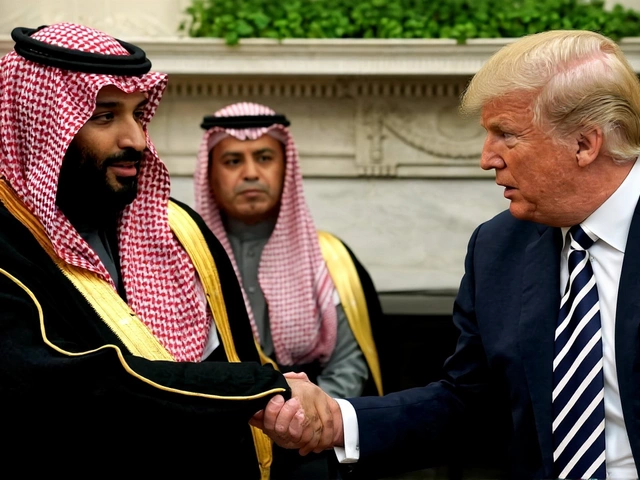Plot, Characters, and Core Themes
When One Battle After Another opened in theaters on September 26, 2025, audiences got a thriller that also feels like a social lesson. The film is directed by Paul Thomas Anderson, and it marks the debut of newcomer Chase Infiniti as a producer. Leonardo DiCaprio plays Bob, a man who once went by Pat, and whose whole world collapses when his daughter Willa is taken by the brutal Colonel Lockjaw.
The setting is a United States split by politics and swamped with police. Anderson paints a picture of a country where every street feels watched, and the idea of “freedom” is constantly tested. In that world, Bob’s mission is simple: get Willa back, no matter the cost. The chase sequences feel real because they are built on a mix of gritty realism and cinematic flair – you can hear the engines, feel the tension, and see the stark contrast between a cramped, over‑policed city and the open road where freedom seems possible.
Lockjaw, the film’s main villain, is a scary mix of charisma and cruelty. He runs a secret facility where he keeps people like Willa as pawn pieces. But the twist comes when his own white‑supremacist group, the Christmas Adventurers Club, discovers that Lockjaw once had an interracial relationship. That secret triggers his execution by the very people he tried to impress. Anderson uses this irony to show how hateful ideologies often turn on themselves.
Willa’s character arc drives the emotional heart of the story. At the start, she’s a scared teenager locked inside a cold room. After her daring escape, she takes the wheel in a high‑speed chase, tracks down a member of the Adventurers Club, and kills him. That moment flips her from a passive victim to a person who takes action. The film doesn’t shy away from the trauma she’s endured; instead, it shows how that pain can become a source of power.
Eric Schweig’s Avanti, a bounty hunter hired to capture Willa, goes through his own change. He starts as a typical mercenary, but as the plot unfolds, he decides to protect Willa and ends up sacrificing his life. This sacrifice adds another layer to the story’s idea that people can change, that redemption is possible even for those who began on the wrong side.
The reunion between Bob and Willa is a classic Hollywood moment, but Anderson adds a twist: Bob hands Willa a letter from her mother Perfidia, who has been hiding out of danger. The note carries love, hope, and a reminder that the fight they’re in is larger than any single battle.
The final scene does something unusual. Instead of ending with a tidy resolution, Willa receives news of a protest in Oakland. She gets into a car and drives toward the demonstration, signaling that while Lockjaw is gone, the larger war against oppression continues. Anderson’s message is clear: each generation must pick up the torch.

Impact, Reception, and What It Means for the Future
The film’s title, One Battle After Another, isn’t just a catchy phrase; it’s a blueprint for how Anderson sees social change. Critics have praised the movie for balancing action with political commentary, noting that it doesn’t preach but shows the ugly side of hate and the power of resistance.
Box‑office numbers tell a story of their own. In its opening weekend, the film earned $45 million domestically, beating expectations for a drama‑thriller hybrid. Internationally, it pulled in another $30 million, especially in countries where discussions about police overreach are already happening. The audience demographics skew younger, with many viewers saying they felt inspired to learn more about local protests after leaving the theater.
From a filmmaking perspective, Anderson’s choice of cinematographer—longtime collaborator Robert Elswit—adds to the gritty feel. The color palette is muted, dominated by cold blues and harsh whites, mirroring the oppressive environment. The car chase scenes use practical effects rather than CGI, giving them a raw, immediate vibe that makes the audience’s heart race.
Musically, the score mixes electronic beats with folk instruments, reflecting the clash between modern surveillance and the old‑world spirit of protest. The main theme plays softly when Willa reads her mother’s letter, then swells as she drives toward the Oakland protest, underscoring the emotional shift from personal loss to collective action.
The film also sparked conversations on social media. Hashtags like #WillaRevolution and #OneBattleAfterAnother trended for days, with users sharing stories of family members who fought for civil rights. Some activists pointed out that Anderson’s depiction of the white supremacist club mirrors real‑life extremist groups, raising awareness about how hate can be self‑destructive.
Academically, the movie is already being used in university courses about film and social movements. Professors note that the film’s structure—one climactic battle followed by an open‑ended call to action—mirrors the real pattern of protest cycles: a flashpoint, a response, then a new flashpoint.
Looking ahead, the film could influence how Hollywood tackles political topics. By showing that a blockbuster can carry a serious message without losing audience appeal, Anderson may encourage other directors to tackle systemic issues head‑on. The success of the movie suggests that viewers are hungry for stories that reflect the complexities of today’s world.
Finally, the personal stories within the film—Bob’s desperate fatherhood, Willa’s transformation, Avanti’s redemption—remind us that large‑scale fights are made up of countless individual choices. The film leaves us with a simple, powerful idea: the war for justice never ends, but each new participant adds a fresh voice, a new energy, and a chance to keep the movement alive.





Tulis komentar